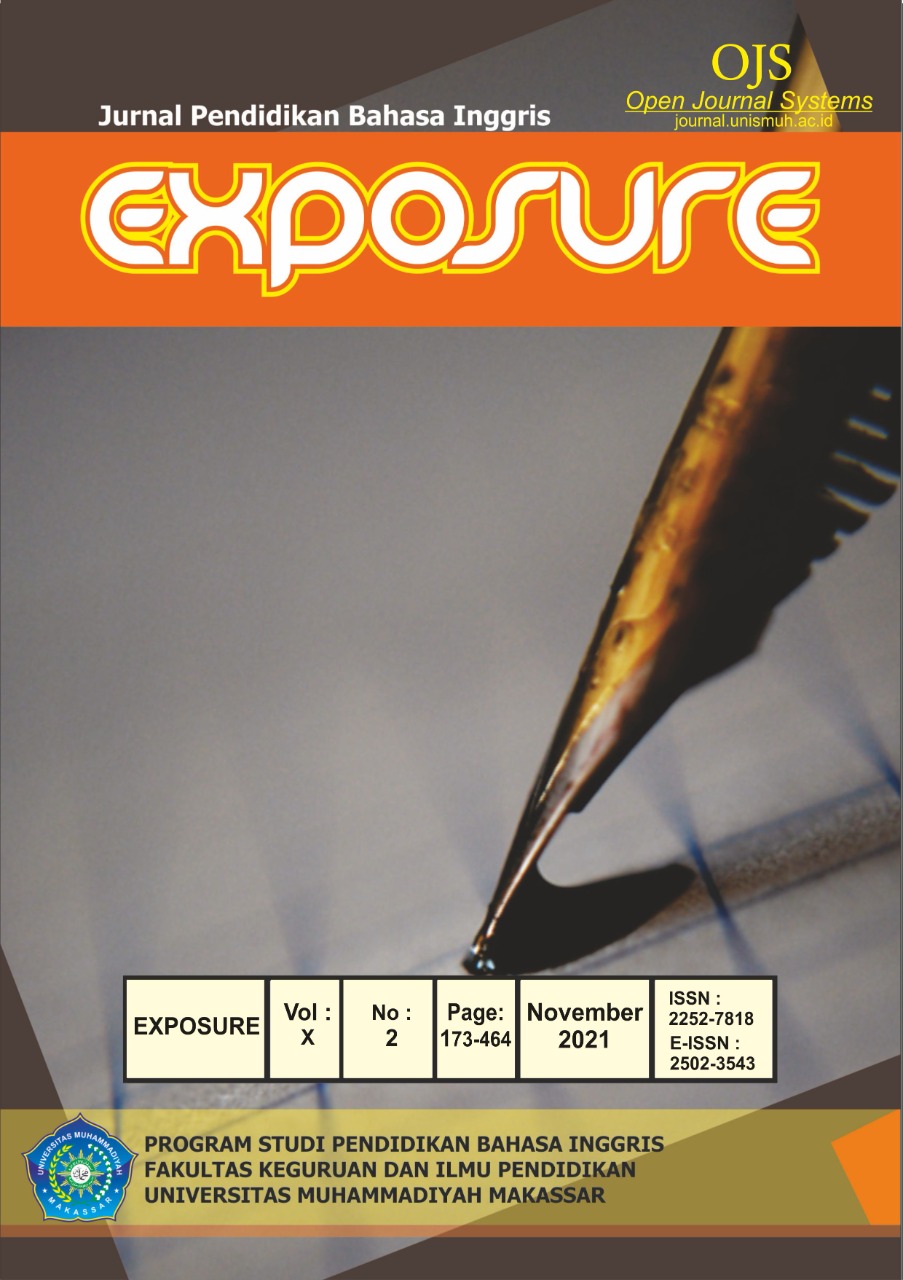ENGLISH VIRTUAL BASED LEARNING: INTEGRATING TECHNOLOGY AND LEARNING MEDIA THROUGH ‘ASSURE’ TEACHING MODEL
DOI:
https://doi.org/10.26618/exposure.v10i2.6054Keywords:
ASSURE teaching model, technology utilisation, virtual teachingAbstract
This research had the objective to measure the effectiveness of ASSURE teaching model in the integration of technology and learning media in the process of virtual-based English learning. One class comprising of 20 students of 6th grade was chosen as the sample of this study. A quantitative descriptive method was applied by using both pre-and post-tests as the instruments in collecting the data. In analyzing the data, the average score difference gained by the students in these two tests was firstly measured before they were further calculated through the 'Paired sample t-test'. The analysis revealed that the mean score reached by the students in the post-test (80.75) was higher than their performance in the pre-test (56). Additionally, the t-test score hit by these students was 14.14; bigger than the value of the t-table (1.73) in the significance level of 5% (0.05). This also explained that ASSURE teaching model as variable X significantly influenced students' English achievement (variable Y). These findings confirmed that in the integration of technology and learning media in English virtual instruction, ASSURE teaching model was effective in increasing students' English achievements.
References
Ally, Mohamed. (2019). Competency profile of the digital and online teacher in future education. The International Review of Research in Open and Distributed Learning, 20 (2), http://doi.org/10.19173/irrodil.v20i2.4206
Gul, Mine K., Altun, Sertel & Yabas, Defne. (2020). Investigation of the effect of course design prepared according to ASSURE model principles on students ulakbilge, 54., pp. 1265-1276, doi: 10.7816/ulakbilge-08-54-01.
Kim S, Kim Y. J., Peck K. R., Jung E. (2020). School opening delay effect on transmission dynamics of coronavirus disease 2019 in korea: based on mathematical modelling and simulation study. J Korean Med Sci, 35.
Ally, M. (2019). Competency profile of the digital and online teacher in future education. The International Review of Research in Open and Distributed Learning. Vol. 20 (2), http://doi.org/10.19173/irrodl.v20i2.4206.
Konig, et.al,. (2020). Adapting to online teacher during COVID-19 school closure: teacher education and teacher competence effects among early career teachers in germany, European Journal of Teacher Education, 43 (4), 608-622, DOI:10.1080/02619768.2020.1809650.
McFarlen, Angela E. (2019). Devices and desires: Competing visions of good education in the digital age. British Journal of Education Technology, 50 (3), 1125-1136, http://doi.org/10.1111/bjet.12764.
Sahertian, C. D. W., Wajabula, C. M. & Amtu, O. (2020). Contribution of ASSURE Learning Modelto Improve Student Learning Skills. Journal of Critical Reviews, 7 (9), 1130-1134.
Santoso, Iman. (2014). pembelajaran bahasa asing di indonesia: antara globalisasi dan hegemoni. Bahasa & Sastra, 14 (1), 1-11, retrieved on July 19, 2021.
Selwyn, Neil. (2012). Making sense of young people, education and digital technology: The role of sociological theory, Oxford Review of Education, 38 (2), 81-96.
Sharma & Barret. (2008). Blended learning: using technology in and beyond the language classroom. Educational Technology & Society, 11, 289-291
Zubaedi, M., Hakim, M. A., Rahman & Asiyah. (2020). The use of the ASSURE model in developing animation video as English teaching materials for Islamic kindergarten students. International Journal of Innovation, Creativity and Change, 11 (10), 1-19, www.ijicc.net.
Downloads
Published
Issue
Section
License
Authors who publish with this journal agree to the following terms:
In order to assure the highest standards for published articles, a peer review policy is applied. In pursue of the compliance with academic standards, all parties involved in the publishing process (the authors, the editors and the editorial board and the reviewers) agree to meet the responsibilities stated below in accordance to the Journal publication ethics and malpractice statement.
Duties of Authors:
- The author(s) warrant that the submitted article is an original work, which has not been previously published, and that they have obtained an agreement from any co-author(s) prior to the manuscript’s submission;
- The author(s) should not submit articles describing essentially the same research to more than one journal;
- The authors(s) make certain that the manuscript meets the terms of the Manuscript Submission Guideline regarding appropriate academic citation and that no copyright infringement occurs;
- The authors(s) should inform the editors about any conflict of interests and report any errors they subsequently, discover in their manuscript.
Duties of Editors and the Editorial Board:
- The editors, together with the editorial board, are responsible for deciding upon the publication or rejection of the submitted manuscripts based only on their originality, significance, and relevance to the domains of the journal;
- The editors evaluate the manuscripts compliance with academic criteria, the domains of the journal and the guidelines;
- The editors must at all times respect the confidentiality of any information pertaining to the submitted manuscripts;
- The editors assign the review of each manuscript to two reviewers chosen according to their domains of expertise. The editors must take into account any conflict of interest reported by the authors and the reviewers.
- The editors must ensure that the comments and recommendations of the reviewers are sent to the author(s) in due time and that the manuscripts are returned to the editors, who take the final decision to publish them or not.
Authors are permitted and encouraged to post online a pre-publication manuscript (but not the Publisher’s final formatted PDF version of the Work) in institutional repositories or on their Websites prior to and during the submission process, as it can lead to productive exchanges, as well as earlier and greater citation of published work (see The Effect of Open Access). Any such posting made before acceptance and publication of the Work shall be updated upon publication to include a reference to the Publisher-assigned DOI (Digital Object Identifier) and a link to the online abstract for the final published Work in the Journal.

